In 2016, sales of new energy passenger vehicles experienced a continuous increase in the first half of the year, falling from 34,000 vehicles to nearly 30,000 vehicles in July, and then maintaining a level of 30,000 vehicles for four consecutive months, which showed a sharp increase in November. 40,000 vehicles failed to continue this growth in December. The year-end effect presented last year was not obvious this year.
During the policy adjustment period, most of the car companies were in a wait-and-see state, which led to the market failing to develop as expected. At the end of 2016, the financial subsidy policy for the promotion and application of new energy vehicles was revised, the entry threshold for recommended models was improved, the requirements for energy consumption of vehicles and the performance safety of power batteries were increased, and the dynamic management system of the Catalogue was established. After the new energy automobile products are included in the Catalogue, the sales promotion can apply for subsidies. A series of adjustments to the standard conditions have required some of the models to be sold to be adjusted. Reiterating the catalogue makes it necessary for companies to have a 1-3 month cycle. It is foreseeable that the sales market in the first quarter of 2017 will not show significant growth.
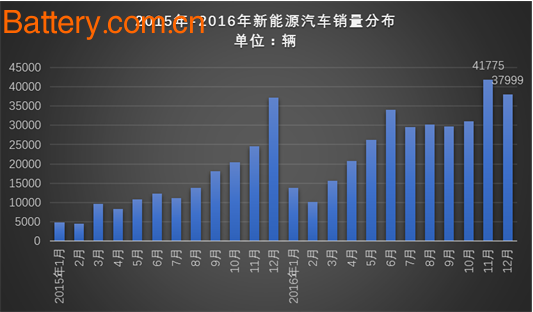
According to statistics from the Federation, the sales volume of new energy passenger cars in December was 38,000, showing a year-on-year growth rate and a decline in the chain, up 2% year-on-year and 9% quarter-on-quarter. In December, the growth rate of plug-in hybrid passenger vehicles was weaker than that of pure electric cars. The number of pure electric passenger cars increased by 12% year-on-year, but the mix and tear decreased by 25%. On a month-on-month basis, the decline in pure electric passenger cars was higher than that in plug-in type. In December, pure electric passenger cars showed a 16% decline, and plug-in passenger cars increased by 52%.
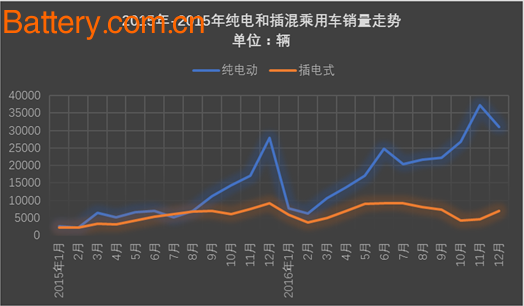
On the cumulative side, the total sales volume of new energy passenger vehicles in January-December 2016 has reached 320,000 units, an increase of 84% year-on-year. Among them, pure electric vehicles sold 240,000 units, a year-on-year increase of 116%, accounting for up to 75%; plug-in hybrid sales of 80,000 units, an increase of 26%, accounting for 25%. Among them, BYD, Geely and Beiqi ranked the top three in total sales of new energy passenger vehicles.
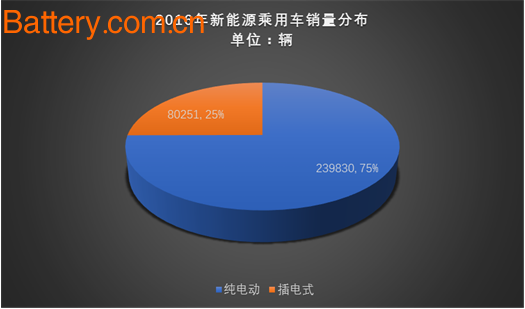
According to the provinces and cities, according to the data of the first ten months of the strong insurance, Beijing's new energy vehicles reached 50,000, of which the basic is pure electric vehicles, and the intermixing accounted for 1%, which also determines the development of the national new energy vehicle market. The model is characterized by pure electricity, and the local characteristics determine the market model. Unlike Beijing, Shanghai and Guangdong provinces mainly focus on mixed-mix vehicles, including 38,000 new energy vehicles in Shanghai, 80% of which are intermixed, and nearly 20% are pure electric. There are 31,000 new energy vehicles in Guangdong Province, and the ratio of pure electric and plug-in models remains 1:2.

Pure electric passenger car: Geely's monthly sales are approaching 10,000 units.
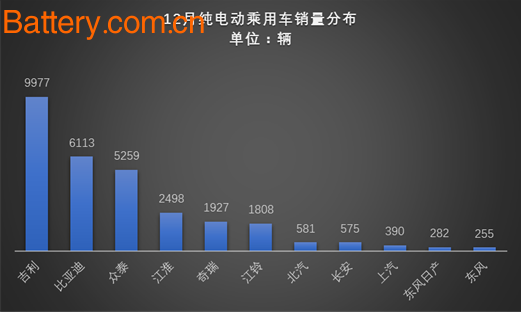
As the main market force in the field of new energy vehicles , the sales of pure electric passenger vehicles have always been consistent with the overall market trend. They continued to grow in the first half of the year. After the short-term adjustment in July, the sales volume continued to rise in August and November, reaching a peak of nearly 40,000 in November. There was another small decline in December. According to statistics from the Federation, the sales of pure electric passenger cars in December was 31,100.
According to the car-dividers, there were 11 car companies with sales in December, and 3 companies with more than 5,000 cars sold: BYD (6,113), Geely (9977), and Zotye (5,259). The cumulative sales of the three car companies reached 21,349 units, accounting for 69%. Among them, Geely and BYD's sales growth was obvious, and the net sales in December exceeded 1,000. Among them, Geely's performance was more prominent, with a growth rate of 43%. BYD has climbed in the past few months. After more than 5,000 vehicles in September, the sales data in October increased significantly to 7,000 units, while in November and December it showed a slight fluctuation, maintaining 6000 levels. In contrast, most of the automakers, including Chery, Jiangling, Beiqi, and Zotye, also experienced a similar decline in December. Among them, especially the decline of BAIC is the most obvious. In December, the sales volume was less than 1,000 vehicles, slipping to 528 vehicles, a drop of 88%. Secondly, Zotye surged to 12,000 vehicles in November, and quickly slipped to an average of 5259 vehicles in December. , a drop of 57%. Chery and Changan's sales in December were all above 40%, reducing by more than 1,000.
Looking at the whole year, the top three automakers in the sales of pure electric passenger vehicles in January-December 2016 were Geely, BYD and BAIC. The output of the three car companies exceeded 40,000 units, with an accumulated output of nearly 140,000 units, accounting for 56% of the total number of pure electric passenger cars. Secondly, Zotye sold 37,000 units, accounting for 15%; Jianghuai 18,800 units (8%); Chery 17,000 units (7%); Jiangling 14,000 units (6%); Changan 6336 units (3%); Dongfeng Nissan 1893 Vehicle, Dongfeng 629.
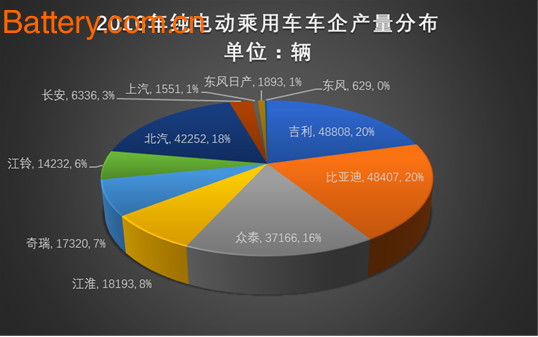
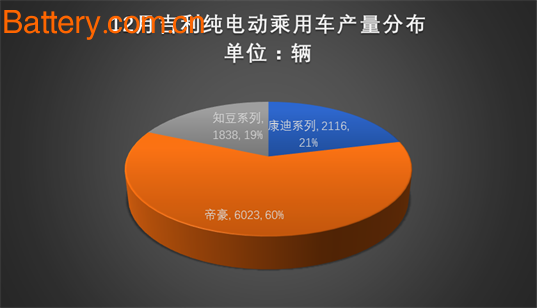
Geely, which ranked first in December, contributed to the sales contribution of Emgrand EV. Its monthly sales rose to 6023 units, a 59% increase from the previous month. The market sales increased by more than 2,000 units, accounting for 60% of the total Geely. Secondly, the sales of the Zhidou and Kangdi series models reached 1,838 and 2,116 respectively, accounting for 19% and 21% respectively.
Secondly, BYD ranked second in sales of 6,113 vehicles in December, an increase of 28% from the previous month. Its pure electric vehicles mainly include BYD e6\e5\Qin EV\Tengshi. In December, sales of e5\e6 continued in November, both of which exceeded 2,000 units, accounting for 81% of BYD's pure electric passenger vehicle sales. BYD's sales of EV models exceeded 2,000 units in October, in November and December. The number of vehicles dropped to 519 units, while the sales volume of the Tengshi model increased significantly in December. The sales volume exceeded the number of Qin EVs to 646 units, a 1.9 times increase from the previous month.
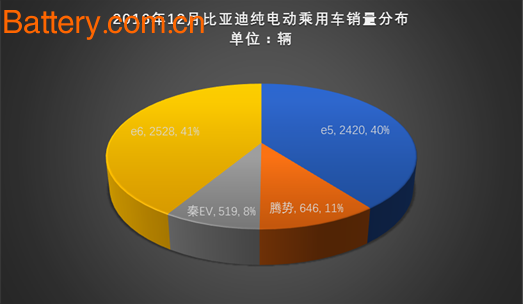
The third-ranked Zotye sold 5,259 vehicles in December, a 57% drop from the November data. The sales volume of its main models, Cloud 100, E200 and E30, was 1,615, 2,213 and 805 respectively. Among them, the sales volume of the cloud 100 model decreased the most, which was more than 3,000 vehicles, and the E200 decreased by more than 1,000 vehicles.
Jianghuai, which ranked fourth, sold 2,498 units in December, up 105% from the previous month. The sales of its iEV 4 and iEV 5 models exceeded 1,000 units, reaching 1,407 units and 1,088 units, while the iEV 6S model sold 3 units in December.
The sales volume of Beiqi in December was only 581, and the sales volume decreased by 88%. The sales of its E-series, EU260 and EX200 models all decreased in different degrees. Among them, the sales volume of Beiqi EU260 was the biggest, down from 3769 in November to 12 309 vehicles in the month, a drop of 92%.
Plug-in passenger car: Arrizo 7e leaps to sales in the first December sales of 2922 vehicles
Unlike the sales trend of pure electric passenger cars, the plug-in passenger car has maintained its continuous sales in March after it surpassed 9,000 vehicles in May, and it has experienced a continuous decline in 8-11, of which the month-on-month decline in October has expanded to 44%; November Maintaining a level of 4,000 vehicles, it rose slightly to 6,899 vehicles in December, an increase of 52% from the previous month.
Among them, the sales of plug-in passenger cars in October did not continue to be distributed. Chery's sales of the Arrizo 7e model jumped to 2,292, surpassing BYD's top position, accounting for 42% of plug-in passenger car sales. . BYD and SAIC basically maintained their sales levels in November, with 2,331 vehicles and 1,064 vehicles respectively, with market share slipping to 34% and 15%.
December's plug-in passenger car sales champion Arrizo 7e is Chery's first plug-in hybrid system model, which sold in 176 in October. The appearance of the Arrizo 7e is basically the same as the gasoline version. In terms of power, the Ariza 7 is equipped with a plug-in hybrid system consisting of a 1.6L gasoline engine and an electric motor. It matches the CVT gearbox with a minimum fuel consumption of only 1.9L/100km and a battery capacity of 9.2kWh. The pure electric drive has a longer range. 50km.
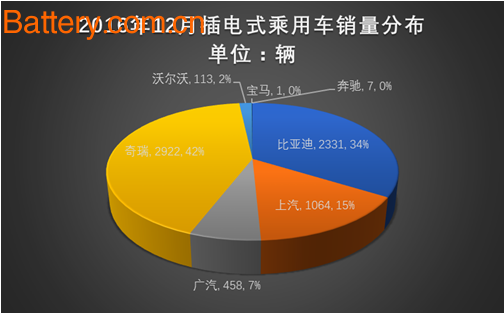
Among them, BYD Qin and Tang sales in December were 821 vehicles and 1510 vehicles respectively, which showed a slight decline from the previous month. After SAIC increased its sales volume to 2,110 units in April, it continued to exert its strength in May, June and July, maintaining a small increase and continued to expand its market share. After the decline in October, the monthly sales in November and December rebounded to the level of 1,000. The plug-in models mainly include the Roewe e550 and e950. The sales of the two cars were 620 and 440 respectively.
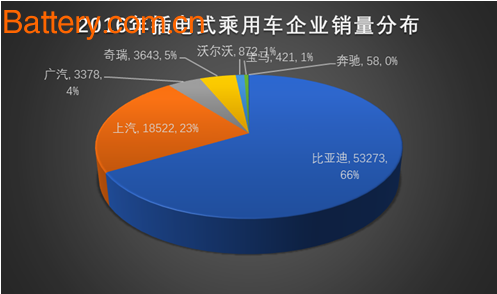
On the cumulative side, in 2016, BYD plug-in passenger car sales reached 53,300 units, accounting for 66% of the market share; SAIC's 18,500 units, accounting for 23%; Chery's sales of 3,643 units, accounting for 5%.
wenzhou gugao international trade CO.,LTD. , https://www.gugaotrade.com